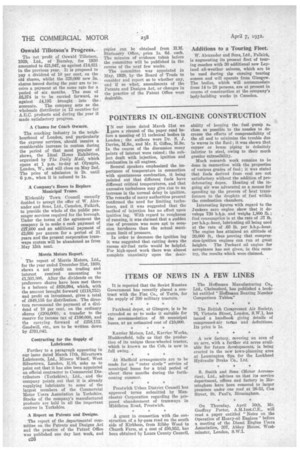POINTERS IN OIL-ENGINE CONSTRUCTION
Page 64

If you've noticed an error in this article please click here to report it so we can fix it.
TN our issue dated March 31st we .1.gave a resume of the paper read before a meeting of 11 technical bodies in London ; the authors were Dr. S. J. Davies, M.Sc., and Mr. E. Giffen, M.Sc. In the course of the discussion many points of interest were raised ; the subject dealt with injection, ignition and combustion in oil engines.
Several speakers emphasized the importance of temperature in connection with spontaneous combustion, it being pointed out that different fuels have different critical temperatures, and that excessive turbulence may give rise to an increase in the normal delay in ignition. The remarks of many authorities present confirmed the need for limiting turbulence, and it was suggested that the method of injection has no effect upon ignition lag. With regard to roughness of running, it was claimed that a sudden rise of pressure was more apt to occasion harshness than the actual maximum limit of pressure.
In order to decrease the ignition lag it was suggested that cutting down the excess air-fuel ratio would be helpful. For high-speed work there was almost complete unanimity upon the desir ability of keeping the fuel pump as close as possible to the nozzles to decrease the effects of compressibility of the oil and to minimize the trouble due to waves in the fluid ; it was shown that copper or brass piping is definitely inferior to steel, owing to their much greater extensibility.
Much research work remains to be done in connection with the properties of various grades of fuel; it was stated that fuels derived from coal are not satisfactory without the addition of prodetonating dopes. Heating of the ingoing air was advocated as a means for speeding up the process of heat transference to the droplets of fuel within the combustion chambers.
Interesting figures with regard to the Junkers aero engine show that it develops 720 b.h.p. and weighs 1,800 lb. ; fuel consumption is at the rate of .37 lb. per b.h.p.-hour, lubricating oil being used at the rate of .03 lb. per b.h.p.-hour. The engine has attained an altitude of 20,000 ft., thus proving that compression-ignition engines can run at great heights. The Packard oil engine for aeroplanes has not given, in this country, the results which were claimed.




























































































































